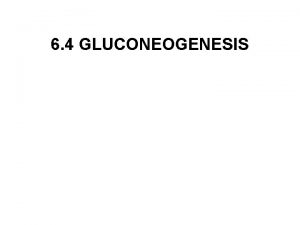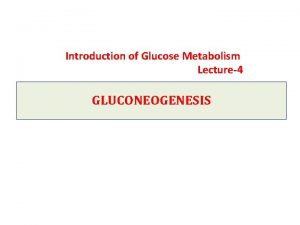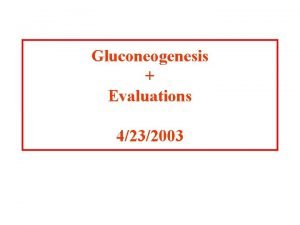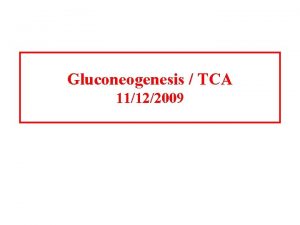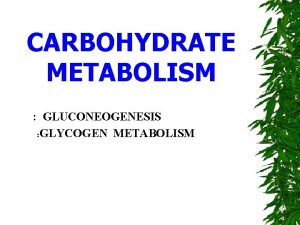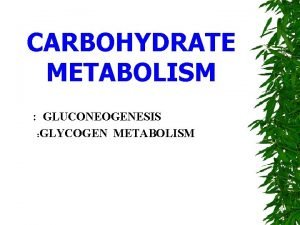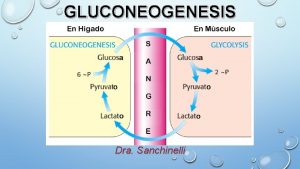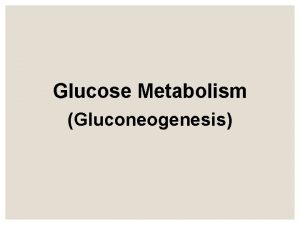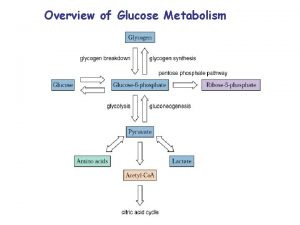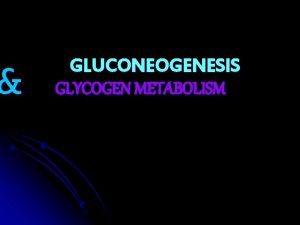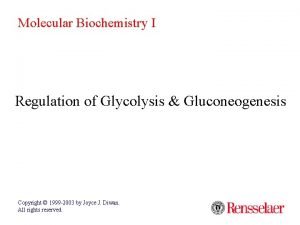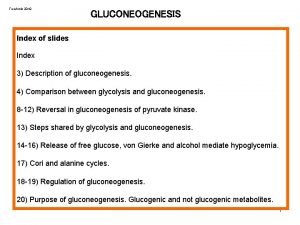Gluconeogenesis What is the Gluconeogenesis Gluconeogenesis is making
























- Slides: 24

Gluconeogenesis

What is the Gluconeogenesis? Ø Gluconeogenesis is making a new glucose from non-carbohydrate precursors Ø In other words: Create new glucose from the products of its breakdown Ø Its main function is to supply blood glucose in cases of carbohydrate deficiency (fasting, starvation and low carbohydrate diet).

Sites for gluconeogenesis Ø Cytoplasm and mitochondria of liver and kidney tissues due to presence of glucose-6 phosphatase and fructose-1, 6 -biphosphatase. Ø The production of glucose is necessary for use as a fuel source by the brain, testes, erythrocytes, kidney medulla, lens and cornea of the eye and exercising muscle.

Glycolysis pathway

The reactions of gluconeogenesis: Synthesis of glucose from pyruvate utilizes many of the same enzymes as glycolysis. Three Glycolytic reactions are essentially irreversible w Hexokinase (or Glucokinase) w Phosphofructokinase w Pyruvate Kinase. These steps must be by passed in Gluconeogenesis.

First Bypass Reaction Convervsion of Pyruvate to Phosphoenolpyruvate • Enzymes involved: - Pyruvate carboxylase - PEP carboxykinase

In Mitochondria • Pyruvate carboxylase (PC) exists in the mitochondria of liver and kidney but absent in muscle • ATP, biotin, Mn++ and CO 2 are required.

Transport of Oxaloacetate into cytosol as Malate

In cytosol

Summary of the first bypass

Second bypass reaction Conversion of Fructose 1, 6 - bisphosphate to Fructose 6 -phosphate • The second glycolytic reaction (phosphorylation of fructose 6 -phosphate by PFK) is irreversible. • Hence, for gluconeogenesis fructose 6 -phosphate must be generated from fructose 1, 6 -bisphosphate by a different enzyme which is Fructose 1, 6 -bisphosphatase. • Fructose 1, 6 -bisphosphatase presents in liver and kidney. • This reaction is also irreversible. Fructose 1, 6 -bisphosphate + H 2 O fructose 6 phosphate + Pi

Phosphofructokinase (In Glycolysis): fructose-6 -P + ATP fructose-1, 6 -bis. P + ADP Fructose-1, 6 -bisphosphatase (In Gluconeogenesis): fructose-1, 6 -bis. P + H 2 O fructose-6 -P + Pi

Third bypass reaction Glucose 6 -phosphate to Glucose • Because the hexokinase reaction is irreversible, the final reaction of gluconeogenesis is catalyzed by Glucose 6 -phosphatase. Glucose 6 -phosphate + H 2 O glucose + Pi • Glucose 6 -phosphatase is present in the liver, kidney and small intestine but absent in brain and muscle. Thus, glucose produced by gluconeogenesis in the liver, is delivered by the bloodstream to brain and muscle.

Hexokinase or Glucokinase (In Glycolysis): glucose + ATP glucose-6 -phosphate + ADP Glucose-6 -Phosphatase (In Gluconeogenesis): glucose-6 -phosphate + H 2 O glucose + Pi

Summary of Gluconeogenesis Pathway: Gluconeogenesis enzyme names in red. Glycolysis enzyme names in blue.


Substrates for gluconeogenesis 1 - Lactate (Lactic acid): • In vigorous skeletal muscle activity, large amount of lactic acid produced pass to liver through blood stream converted into pyruvic and lastly to glucose reach muscle again through blood stream to provide energy (Cori cycle).

Lactate produced from pyruvate passes via the blood to the liver, where it may be converted to glucose. The glucose travels back to the muscle to fuel Glycolysis.

Substrates for gluconeogenesis 2 - Glucogenic amino acids: • Amino acids by deamination can be converted into keto acids as pyruvic, ketoglutaric and oxaloacetic acid. • Proteins are considered as one of the main sources of blood glucose especially after 18 hr due to depletion of liver glycogen.

Carbon sources for gluconeogenesis Glucose-alanine cycle: Ø Glucose oxidation produces pyruvate which can undergo transamination to alanine in liver. This reaction is catalyzed by alanine transaminase (ALT). Ø Additionally, during fasting, skeletal muscle protein is degraded yielding high amount of alanine which then enters the blood stream and is transported to the liver. Ø In liver, alanine is converted back to pyruvate which is then a source of carbon atoms for gluconeogenesis. The newly formed glucose can then enter the blood for delivery back to the muscle.



Acetyl Co. A can not produce glucose • Acetyl Co. A cannot give rise to a net synthesis of glucose. This is due to the irreversible nature of the pyruvate dehydrogenase reaction, which converts pyruvate to acetyl Co. A. Pyruvate dehydrogenase • Pyruvate acetyl Co. A + CO 2 NAD+ NADH+H+

Importance of gluconeogenesis 1 -Maintenance of blood glucose during starvation, fasting and prolonged exercise. 2 - Removal of lactic acid. 3 - Removal of glycerol produced by lipolysis.
 What is inference
What is inference War making and state making as organized crime summary
War making and state making as organized crime summary Quá trình desamine hóa có thể tạo ra
Quá trình desamine hóa có thể tạo ra Khi nào hổ mẹ dạy hổ con săn mồi
Khi nào hổ mẹ dạy hổ con săn mồi Các châu lục và đại dương trên thế giới
Các châu lục và đại dương trên thế giới Các loại đột biến cấu trúc nhiễm sắc thể
Các loại đột biến cấu trúc nhiễm sắc thể Bổ thể
Bổ thể Thế nào là sự mỏi cơ
Thế nào là sự mỏi cơ Phản ứng thế ankan
Phản ứng thế ankan Thiếu nhi thế giới liên hoan
Thiếu nhi thế giới liên hoan Tia chieu sa te
Tia chieu sa te Chúa yêu trần thế
Chúa yêu trần thế điện thế nghỉ
điện thế nghỉ Một số thể thơ truyền thống
Một số thể thơ truyền thống Hệ hô hấp
Hệ hô hấp Công thức tiính động năng
Công thức tiính động năng Bảng số nguyên tố lớn hơn 1000
Bảng số nguyên tố lớn hơn 1000 Tỉ lệ cơ thể trẻ em
Tỉ lệ cơ thể trẻ em đặc điểm cơ thể của người tối cổ
đặc điểm cơ thể của người tối cổ Các châu lục và đại dương trên thế giới
Các châu lục và đại dương trên thế giới ưu thế lai là gì
ưu thế lai là gì Thẻ vin
Thẻ vin Môn thể thao bắt đầu bằng từ đua
Môn thể thao bắt đầu bằng từ đua Tư thế ngồi viết
Tư thế ngồi viết Cái miệng bé xinh thế chỉ nói điều hay thôi
Cái miệng bé xinh thế chỉ nói điều hay thôi

























